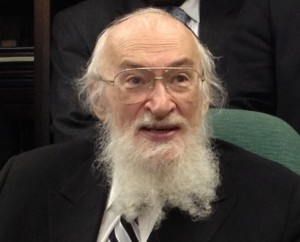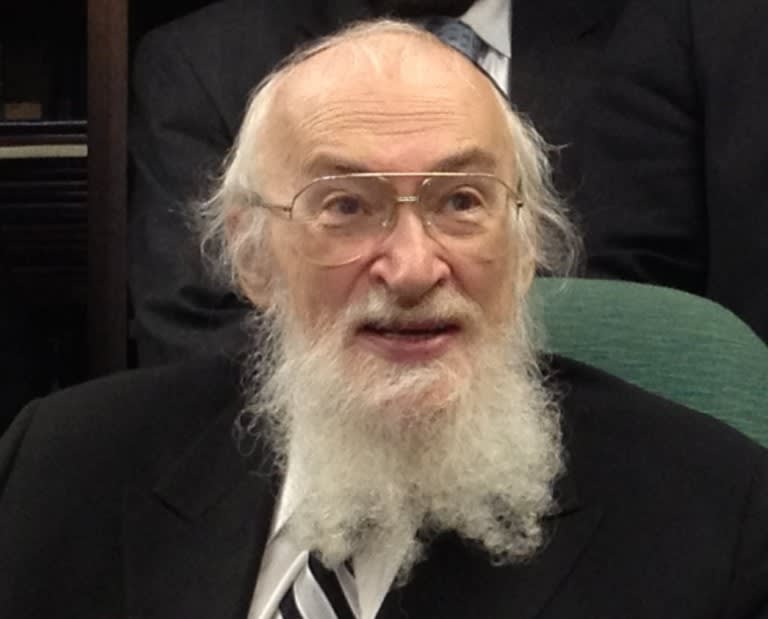 On 20 Adar I/March 2, OU Kosher held a major azkarah for the Shloshim of Rav Chaim Yisroel Belsky zt”l, who served as senior OU posek for Kashrus for almost three decades. The packed crowd, which included OU senior leadership and staff, as well as a large contingency of the Belsky family, heard OU Kosher and guest speakers who knew and worked with Rav Belsky on an intimate level, revealing many insights into his gadlus and contributions to the Torah world and to Kashrus that were heretofore generally unknown.
On 20 Adar I/March 2, OU Kosher held a major azkarah for the Shloshim of Rav Chaim Yisroel Belsky zt”l, who served as senior OU posek for Kashrus for almost three decades. The packed crowd, which included OU senior leadership and staff, as well as a large contingency of the Belsky family, heard OU Kosher and guest speakers who knew and worked with Rav Belsky on an intimate level, revealing many insights into his gadlus and contributions to the Torah world and to Kashrus that were heretofore generally unknown.
In his introductory words, Mr. Harvey Blitz, Chairman of the OU Kashrus Commission, mentioned the acute and deep sense of loss felt at the OU by Rav Belsky’s petirah. The loss has been profound on a personal and professional level, for the OU and for the community as a whole. The immense sense of respect that OU staff had for Rav Belsky makes the loss feel even greater.
Rabbi Menachem Genack, CEO of OU kosher, based his words on a question posed by the Beis Ha-Levi and explained to Rabbi Genack by his own rebbe, Rav Yosef Dov Ha-Levi Soloveitchik zt”l: Why is it that only after the giving of the Luchos Sh’niyos, the Second Tablets at Sinai, did Moshe Rabbeinu’s face shine with the Karnei Hod, the Beams of Radiance? Why not after the Luchos Rishonos, the First Tablets?
The Beis Ha-Levi, based on a Medrash, elaborates that the Torah She-b’al Peh, the Oral Torah, was given specifically with the Luchos Sh’niyos. The reason is that when one learns Torah She-bi’ksav, the Written Torah, he becomes a Tashmish Kedushah, a facilitator for holiness, as the Torah is Gufo Kedushah, inherently holy, and the kedushah conveyed to one who learns Torah She-bi’ksav is thus a derivative kedushah. However, when one learns Torah She-b’al Peh, which has no physical text, but whose words are instead borne in our minds, souls and hearts, he himself becomes Gufo Kedushah. This special Gufo Kedushah status of the Luchos Sh’niyos, representing Torah She-b’al Peh, is what caused Moshe Rabbeinu’s face to radiate.
Rav Belsky had this Gufo Kedushah status, as he was a very repository of the Torah.
Rabbi Genack continued from Rav Soloveitchik, quoting the Gemara in Sotah that when Moshe was niftar, a bas kol emanated and proclaimed “Meis Moshe Rabbeinu, Safra Rabba d’Yisroel – Moshe the Great Scribe of Israel, has passed away.” Why does the Gemara refer to Moshe as Safra Rabba d’Yisroel? Is it merely because Moshe wrote 13 Sifrei Torah before he passed away? No, there are many sofrim who have written many more Sifrei Torah. Rather, it is because Moshe was the Sofer Par Excellence, who wrote the Torah not only on klaf, but on the neshamos and minds of the Jewish People. This holds true for Rav Belsky as well, who was Kulo Torah, who embodied and disseminated Torah to the minds and hearts of all Jewry.
Rabbi Genack further elaborated from Rav Soloveitchik that it was with the Luchos Sh’niyos that Moshe reached his zenith of mesiras nefesh for Klal Yisroel, offering to be obliterated from the Torah for the sake of Klal Yisroel. Furthermore, the Luchos Sh’niyos represent Moshe’s hands-on engagement, as he carved those Luchos on his own. This is why it was the Luchos Sh’niyos that precipitated the Karnei Hod. So too was Rav Belsky moser nefesh for Klal Yisroel, standing in the breach for the interests of Klal Yisroel, both on a communal and individual level. So too was Rav Belsky extremely hands-on with all intricacies of kashrus.
Rabbi Yaakov Gross, a rosh kollel in Miami and son-in-law of Rav Belsky, expressed how much Rav Belsky enjoyed coming to the OU every week for his psak sessions. Rav Belsky viewed it not only as an obligation, but as something from which he derived such satisfaction, and as one of the highlights of his week.
Rabbi Gross briefly spoke about Rav Belsky’s unusual talents and interests, including chemistry, physics, food science and machinery, explaining that it was davka at the OU where Rav Belsky was able to put this technical expertise to use. Rabbi Gross thanked the OU for giving Rav Belsky the opportunity to apply his unique skills for Kashrus and Mitzvos.
Rabbi Asher Weiss, the noted posek and rosh kollel, spoke next, noting in particular Rav Belsky’s outstanding role in the Torah world, insomuch as he was both a major lamdan and a major posek. Rabbi Weiss also explained that Rav Belsky had a total proficiency in the metzi’us of shaylos he was presented with. Rabbi Weiss focused on Rav Belsky’s Kocha D’Heteira, his ability to rule leniently, and how this is the proper derech of Torah, within proper parameters.
Rabbi Moshe Elefant, COO of OU Kosher, knew Rav Belsky for close to 50 years, and elaborated upon the impression that Rav Belsky made upon him and upon the tzibbur. Rabbi Elefant invoked the Yerushalmi in Moed Katan that one who sees a talmid chochom who is niftar is compared with one who sees a Sefer Torah being burned. The Bavli says that one must tear k’riyah twice for witnessing a Sefer Torah destroyed – one time for the parchment, and one time for the writing. Rav Belsky embodied both of these components of a Sefer Torah.
Rabbi Elefant recalled that he first encountered Rav Belsky when Rabbi Elefant was in ninth grade at Torah Vodaas, when Rav Belsky came to the ninth grade class and made a striking impression upon Rabbi Elefant and his fellow talmidim. Rabbi Elefant related that Rav Belsky was a close and intimate part of his and his family’s life for decades, including Rav Belsky serving as Mohel for his grandson’s bris and as participating in the upsherin of every one of Rabbi Elefant’s sons and grandsons, Rav Belsky giving a haskamah for Rabbi Elefant’s sefer on Hilchos Mezuzah and Rav Belsky’s spending time discussing the relevant halachos with Rabbi Elefant. This all represents that, aside from Rav Belsky’s seismic Harbatzas Ha-Torah, “He never forgot to think about the individual”. Rav Belsky took such a keen interest and was so involved with yechidim, individual people, throughout his life.
Rabbi Elefant noted that “Rav Belsky always believed in people. He never wanted to see bad in a person. He always wanted to see the best in everyone… He didn’t know another way.“ Rav Belsky would call Rabbi Elefant at all hours to ask the OU to undertake new initiatives, and Rav Belsky explained that it was davka the OU, as a communal organization and not a profit-driven private hashgacha, which was in the proper position to get the necessary things done in the world of Kashrus.
Rav Belsky once asked Rabbi Elefant to meet him at a local appliance store, explaining that he doesn’t accept the heter of the current appliances designed for Shabbos and Yom Tov use. Rav Belsky wanted to detail to the appliance store owner the proper halachic specifications for Shabbos and Yom Tov appliances, in order that they should be conveyed to appliance manufacturers. “I will be the one to design the oven and get the engineers to produce it.” The OU is still working on this project, as part of the legacy of Rav Belsky.
Rabbi Elefant said that Rav Belsky was not a meikil, but was “an ish ha-emes, who always paskened the Halacha exactly as he saw it.” Rav Belsky dove into the depths of the issue and would not pasken until he reached the emes. For example, Rav Belsky would not accept “Mezonos rolls”, having researched the issue from every angle. Rav Belsky, though, seeking to always offer the positive, thereupon sought to design acceptable versions of such rolls, having worked out a formula for them that would use pea flour! (This never came to fruition.)
Rabbi Yaakov Luban, Senior Rabbinic Coordinator at OU Kosher, related fascinating firsthand incidents and stories of Rav Belsky. Rabbi Luban noted the major respect that non-frum and non-Jewish food manufacturing executives had for Rav Belsky, with whom they met for important meetings. Rabbi Luban related Rav Belsky’s mandate for rebbeim to be moser nefesh and to be responsible for their talmidim’s success, and Rav Belsky’s extreme personal involvement and care for talmidim, fulfilling this very high standard the Rav Belsky set for himself and others.
Rabbi Eli Gersten, Rabbinic Coordinator for Halacha at OU kosher, related that Rav Belsky “was a living Shulchan Aruch, not only in what he said, but also in how he acted”. Rabbi Gersten recalled some of the hanhagos of Rav Belsky that he observed when Rav Belsky would come to the OU every week – his scrupulous adherence to every se’if katan of Shulchan Aruch, such as:
- How Rav Belsky would tear his bread for Hamotzi exactly as described in Shulchan Aruch.
- How Rav Belsky would bow at Modim exactly as described in Shulchan Aruch, even though he was in tremendous pain.
Rabbi Gersten discussed how Rav Belsky loved teaching and how he would bring his talmidim from yeshiva every week for his psak sessions at the OU. If the talmidim did not follow every step of the discussion, Rav Belsky would start over and explain each step.
Rabbi Gersten also discussed how Rav Belsky “always paskened from the sugya, both the sugya of Shas and Rishonim and the sugya d’alma.” Rav Belsky knew all the minhagim and all the metzi’us. “When I go to a wedding, I look at the food, to see what I can eat. Rav Belsky however, looked at all the food to determine what is oleh al shulchan melachim, what berachos can be made…”
Rabbi Gersten discussed how Rav Belsky prevented numerous kashrus tumults and gave the OU a derech in countless such sensitive areas, including orange juice, raisins, tropical oils, dairy cows that undergo stomach surgery, worms in fish, garlic, grapes, and copepods in New York City water.
Rabbi Nachum Rabinowitz, Senior Rabbinic Coordinator at OU Kosher, described the gadlus of Rav Belsky “to be able to relate to people, to understand, and put oneself into the matzav of other people – this was Rav Belsky’s legacy”. The tremendous sense of Ahavas Yisroel that Rav Belsky taught and lived should be captured and embodied by us, resulting in the Ultimate Geulah, concluded Rabbi Rabinowitz.
Rabbi Zvi Belsky then spoke and explained how his father did not just pasken a shailah, but “he taught it, going through everything from the beginning… He seemed to almost have a compulsion to explain things to other people.” Whereas most people who have such a towering knowledge are lonely and even sometimes disdainful of others, as they cannot find others with whom to relate, Rav Belsky sought to bring others closer to him and to share his knowledge with them.
Rabbi Zvi Belsky explained that Rav Belsky did this with all, including the OU staff, “who kept my father company and prevented him from feeling lonely. He loved being here and he loved the company of the OU.”
Yehi zichro baruch.
The words of this author reflect his/her own opinions and do not necessarily represent the official position of the Orthodox Union.

